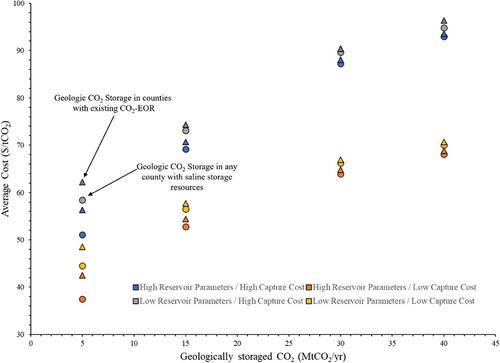下载PDF
{"title":"通过评估堆叠储存的可行性,为俄克拉荷马州的碳捕获和储存制定路线图","authors":"Marcos W. Miranda, Jonathan D. Ogland-Hand, Jeffrey M. Bielicki, Rouzbeh G. Moghanloo, Jamal DaneshFar, Richard S. Middleton","doi":"10.1002/ghg.2244","DOIUrl":null,"url":null,"abstract":"<p>The Intergovernmental Panel on Climate Change concludes that CO<sub>2</sub> capture and storage (CCS) is critical for climate-stabilizing energy transitions. In CCS, captured CO<sub>2</sub> is sequestered in saline aquifers within sedimentary basins. The CO<sub>2</sub> storage capacity and the rate of injection are functions of the geology of the saline aquifer, which is uncertain. To minimize impacts of this uncertainty, CCS projects could include backup plans, such as co-locating geologic CO<sub>2</sub> storage (GCS) sites with or near existing CO<sub>2</sub>-enhanced oil recovery (CO<sub>2</sub>-EOR) operations. These “stacked storage” projects could hedge against uncertainty in the saline formation performance because captured CO<sub>2</sub> could be injected into either location in the event of unexpected events (e.g., the injectivity decreases). Here, we investigate the possibility and ramifications of developing CCS networks in Oklahoma that are amendable to stacked storage. We find that stacked storage is possible in Oklahoma but the counties with the lowest-cost saline storage resources do not have existing CO<sub>2</sub>-EOR operations. At the systems level, we find it is slightly more expensive (e.g., $1/tCO<sub>2</sub> to $5/tCO<sub>2</sub>) to site GCS in counties with CO<sub>2</sub>-EOR projects. This increased expense is largely due to increased CO<sub>2</sub> transportation costs because hundreds of km of additional pipeline is required to capture CO<sub>2</sub> from the lowest-cost sources. Overall, our results suggest that it is optimal to build more pipelines and avoid injecting CO<sub>2</sub> in some of the lowest-cost saline storage resources, to enable capturing CO<sub>2</sub> from the least-cost sources. © 2023 Society of Chemical Industry and John Wiley & Sons, Ltd.</p>","PeriodicalId":12796,"journal":{"name":"Greenhouse Gases: Science and Technology","volume":"13 6","pages":"763-779"},"PeriodicalIF":2.7000,"publicationDate":"2023-11-09","publicationTypes":"Journal Article","fieldsOfStudy":null,"isOpenAccess":false,"openAccessPdf":"https://onlinelibrary.wiley.com/doi/epdf/10.1002/ghg.2244","citationCount":"0","resultStr":"{\"title\":\"Developing a roadmap for carbon capture, and storage in Oklahoma by assessing the viability of stacked storage\",\"authors\":\"Marcos W. Miranda, Jonathan D. Ogland-Hand, Jeffrey M. Bielicki, Rouzbeh G. Moghanloo, Jamal DaneshFar, Richard S. Middleton\",\"doi\":\"10.1002/ghg.2244\",\"DOIUrl\":null,\"url\":null,\"abstract\":\"<p>The Intergovernmental Panel on Climate Change concludes that CO<sub>2</sub> capture and storage (CCS) is critical for climate-stabilizing energy transitions. In CCS, captured CO<sub>2</sub> is sequestered in saline aquifers within sedimentary basins. The CO<sub>2</sub> storage capacity and the rate of injection are functions of the geology of the saline aquifer, which is uncertain. To minimize impacts of this uncertainty, CCS projects could include backup plans, such as co-locating geologic CO<sub>2</sub> storage (GCS) sites with or near existing CO<sub>2</sub>-enhanced oil recovery (CO<sub>2</sub>-EOR) operations. These “stacked storage” projects could hedge against uncertainty in the saline formation performance because captured CO<sub>2</sub> could be injected into either location in the event of unexpected events (e.g., the injectivity decreases). Here, we investigate the possibility and ramifications of developing CCS networks in Oklahoma that are amendable to stacked storage. We find that stacked storage is possible in Oklahoma but the counties with the lowest-cost saline storage resources do not have existing CO<sub>2</sub>-EOR operations. At the systems level, we find it is slightly more expensive (e.g., $1/tCO<sub>2</sub> to $5/tCO<sub>2</sub>) to site GCS in counties with CO<sub>2</sub>-EOR projects. This increased expense is largely due to increased CO<sub>2</sub> transportation costs because hundreds of km of additional pipeline is required to capture CO<sub>2</sub> from the lowest-cost sources. Overall, our results suggest that it is optimal to build more pipelines and avoid injecting CO<sub>2</sub> in some of the lowest-cost saline storage resources, to enable capturing CO<sub>2</sub> from the least-cost sources. © 2023 Society of Chemical Industry and John Wiley & Sons, Ltd.</p>\",\"PeriodicalId\":12796,\"journal\":{\"name\":\"Greenhouse Gases: Science and Technology\",\"volume\":\"13 6\",\"pages\":\"763-779\"},\"PeriodicalIF\":2.7000,\"publicationDate\":\"2023-11-09\",\"publicationTypes\":\"Journal Article\",\"fieldsOfStudy\":null,\"isOpenAccess\":false,\"openAccessPdf\":\"https://onlinelibrary.wiley.com/doi/epdf/10.1002/ghg.2244\",\"citationCount\":\"0\",\"resultStr\":null,\"platform\":\"Semanticscholar\",\"paperid\":null,\"PeriodicalName\":\"Greenhouse Gases: Science and Technology\",\"FirstCategoryId\":\"93\",\"ListUrlMain\":\"https://onlinelibrary.wiley.com/doi/10.1002/ghg.2244\",\"RegionNum\":4,\"RegionCategory\":\"环境科学与生态学\",\"ArticlePicture\":[],\"TitleCN\":null,\"AbstractTextCN\":null,\"PMCID\":null,\"EPubDate\":\"\",\"PubModel\":\"\",\"JCR\":\"Q3\",\"JCRName\":\"ENERGY & FUELS\",\"Score\":null,\"Total\":0}","platform":"Semanticscholar","paperid":null,"PeriodicalName":"Greenhouse Gases: Science and Technology","FirstCategoryId":"93","ListUrlMain":"https://onlinelibrary.wiley.com/doi/10.1002/ghg.2244","RegionNum":4,"RegionCategory":"环境科学与生态学","ArticlePicture":[],"TitleCN":null,"AbstractTextCN":null,"PMCID":null,"EPubDate":"","PubModel":"","JCR":"Q3","JCRName":"ENERGY & FUELS","Score":null,"Total":0}
引用次数: 0
引用
批量引用



